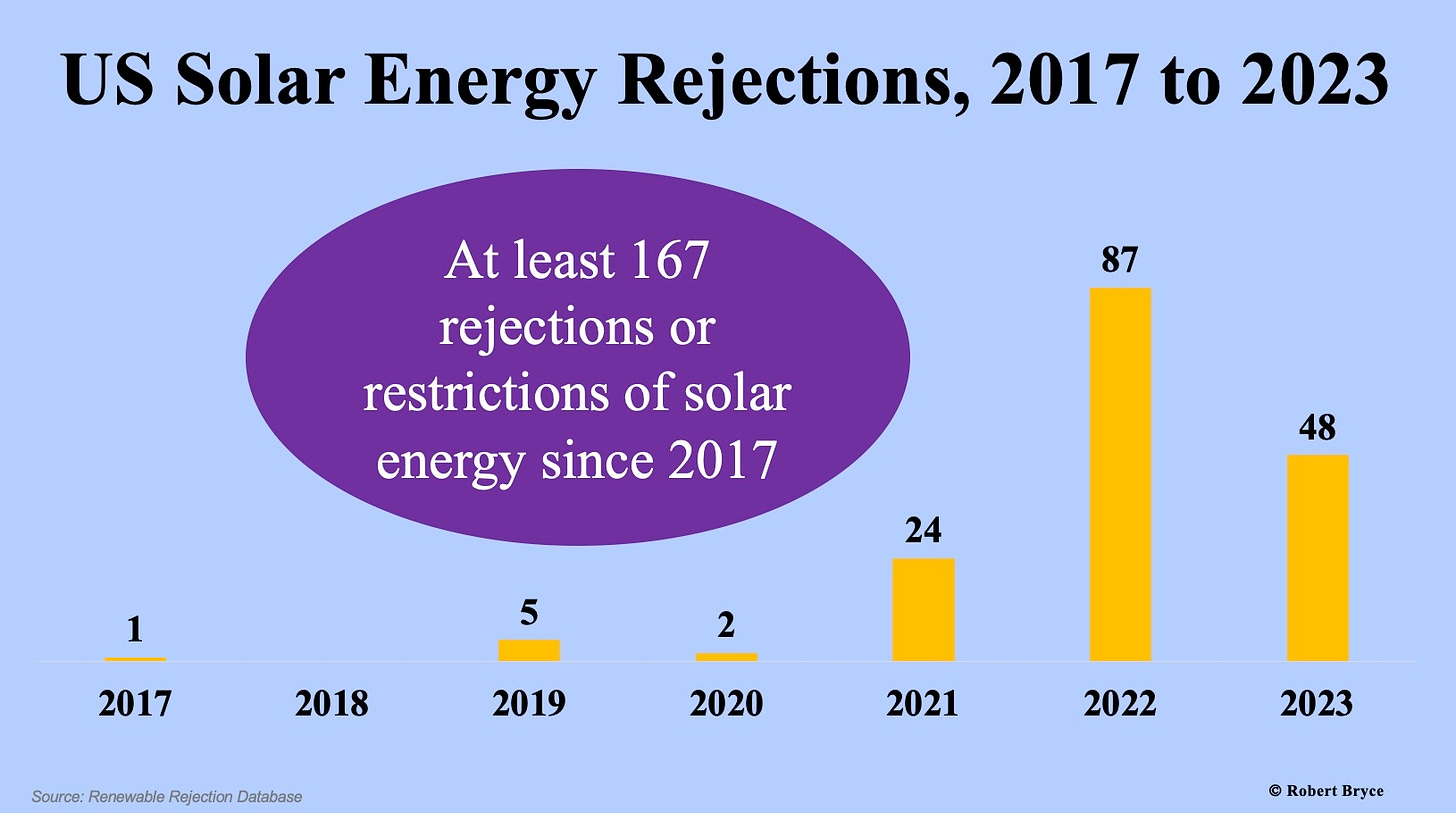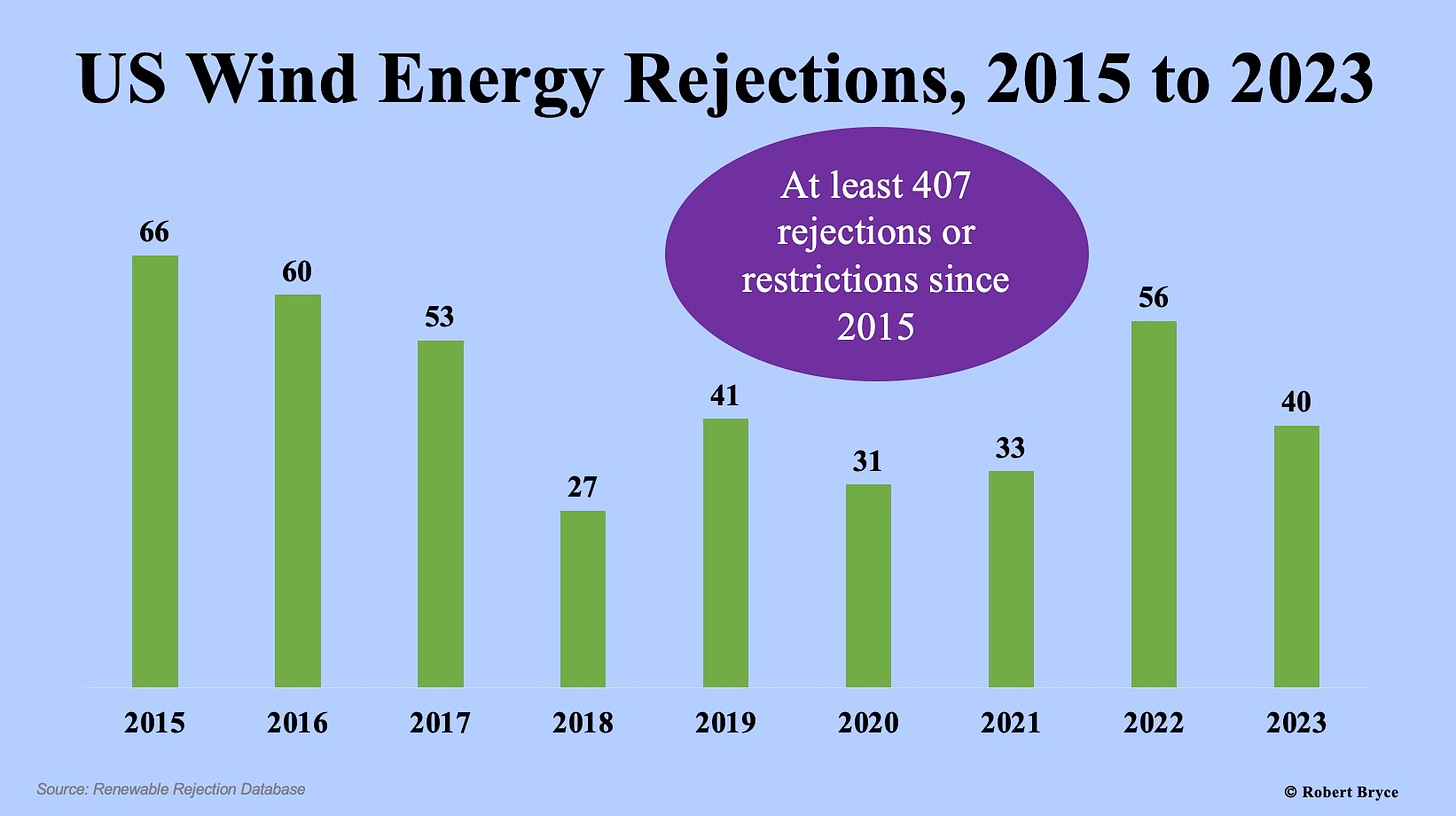Massive Riots, Renewable Resentments
Thousands of Druze rioted in Golan Heights against a wind project, Aussie farmers seek solar ban, Renewable Rejection Database tally hits 574

The warnings about the landscape-destroying sprawl of wind and solar energy have been coming for nearly two decades. The warnings have come from some of the world’s most prominent scientists, government agencies, and energy analysts.
Unfortunately, those warnings were ignored. And now, all over the world, rural people are reacting with fury at the encroachment of large wind and solar projects on their homes and neighborhoods. The backlash has been ongoing for years and can be seen from the Golan Heights to Oahu. Of course, the backlash against the energy sprawl that frequently comes with large-scale renewable projects doesn’t fit the narrative being pushed by climate activists, anti-industry NGOs, and their myriad allies at legacy media outlets.
Despite the dearth of honest reporting from outlets like the New York Times and National Public Radio, the backlash is irrefutable, it’s growing, and it’s happening on multiple continents. In June, thousands of Druze residents in the Golan Heights rioted to stop the installation of a large wind project on their traditional lands. Last month, Australia’s largest farmers union said it wanted a moratorium on new solar projects. In May, a wind project in Colombia being pushed by the Italian company, Enel, was canceled after it met fierce opposition from the indigenous Wayuu communities.
Meanwhile, here in the U.S., over the last 10 days, local governments in Illinois, Ohio, and Iowa have rejected or restricted wind and solar projects. Those moves bring the total number of rejections or restrictions in the Renewable Rejection Database to 574.
I’ll dive into the details of what’s happening in Israel, Australia, Colombia, and places like Erie County, Ohio, in a moment. First, it’s essential to put these land-use conflicts into historical context. And that requires a review of the warnings about renewables and land use that have been made over the past two decades. For instance, in 2004, Jesse Ausubel, the director of the Program for the Human Environment at Rockefeller University, declared that “Solar and the so-called renewables are not green when considered on the large scales required.” In a piece titled “Big Green Energy Machines,” he wrote:
Solar and renewables in every form require masses of machinery to produce many megawatts. They lack efficiencies and economies of scale. Like low-yield farming, to produce more calories, solar and renewables multiply in extent, linearly. Unlike the Internet, solar and renewables cannot become much smaller as they become much larger.
In 2005, Klaus Lippold, a member of the German parliament, told The Guardian that "The problem with wind farms is that you have to build them in places where you don't need electricity. The electricity then has to be moved somewhere else...There is growing resistance in Germany to wind farms, not least because of the disastrous effect on our landscape."
In 2008, The Guardian newspaper published an interview with James Lovelock, the chemist and writer who became famous for the Gaia theory of the earth. Lovelock “saves his thunder for what he considers the emptiest false promise of all — renewable energy.” The paper then quotes him directly: “Windmills! Oh no. No way of doing it,” Lovelock said. “You can cover the whole country with the blasted things, millions of them. Waste of time."
In his 2012 book, The Carbon Crunch, How We’re Getting Climate Change Wrong — and How to Fix It. Dieter Helm, a professor of energy policy at Oxford University, declared, “Even if we devoted all our resources to current wind and solar technologies, they would not be anything like enough to solve the problem of climate change. There simply is not enough land.”
In 2016, shortly before his death, at age 46 from cancer, David J.C. MacKay, a physics professor at the University of Cambridge, said wind turbines are “a waste of money.” Eight years earlier, MacKay had published Sustainable Energy — Without the Hot Air, a remarkable book that hammered home the land-use impacts of renewables. (It’s available for free download.) MacKay, who recognized nuclear must be part of any effort to reduce carbon-dioxide emissions, calculated that wind energy needs about 700 times more land to produce the same amount of energy as a fracking site. In the same 2016 interview, MacKay called the idea of relying solely on renewables an “appalling delusion.” He continued, “There’s so much delusion and I think it’s so dangerous for humanity that people allow themselves to have these delusions that they’re willing to not think carefully about the numbers and the realities, and the laws of physics and the realities of engineering... humanity really does need to pay attention to arithmetic, and the laws of physics.”
But humanity — or rather, our politicians — haven’t paid the slightest attention to math and physics. And the headlong rush for larger and larger renewable projects has led to significant acts of civil disobedience here in the U.S. In 2010, five people, including some members from the environmental group Earth First!, were arrested near Lincoln, Maine, after they blocked a road leading to a construction site for a 60-megawatt wind project on Rollins Mountain. According to the Portland Press Herald, one of the protesters carried a sign which read, “Stop the rape of rural Maine.”

In 2019, about 200 people were arrested on the island of Oahu while protesting a wind project being built by AES near the village of Kahuku. As I reported in The Hill:
The protests are happening in Hawaii, a state that has pledged to generate 100 percent of its electricity by 2045...they are the latest example of the raging land-use conflicts over renewable-energy projects that are happening from Oahu to Iowa and Norway to Germany.” I continued, saying “the conflicts are a harbinger of more clashes to come if governments attempt to install the colossal quantities of wind turbines and solar panels that would be needed to fuel the global economy.
But the 2019 protests on Oahu were nothing compared to the recent riots in the Golan Heights. Here’s how The Times of Israel reported it on June 21:
Thousands of Druze residents of the Golan Heights rioted for the second day Wednesday against the construction of a new wind farm near the town of Majdal Shams, burning tires and hurling rocks, fireworks and Molotov cocktails at massive police forces securing the area. The Israel Police urged the public to stay away. Twelve police officers were wounded. Four demonstrators were seriously injured, one of them from gunfire, along with three moderately and one lightly.
The wind project is being developed by Energix, a publicly traded Israeli company. The project, which was to have 41 turbines, is not mentioned on the company’s website. The June 21 story continued:
The mayor of the Druze town of Daliyat al-Karmel, Rafik Halabi, told several Hebrew media outlets that the protests could spiral into an “intifada” — the term for an uprising used for two major waves of Palestinian terror attacks against Israelis — and that the community was experiencing “great fury” at Israel’s policies and planning laws.
On June 24, The Times of Israel reported that “The head of the Druze community in Israel, Sheikh Muafak Tarif, has warned the government to stop the work to construct wind turbines in the Golan Heights, or face ‘a reaction the country has hitherto not seen.’” The article continued, saying the wind project has:
Angered Druze villagers who see the project as a threat to their agrarian way of life, an encroachment on ancestral lands and a solidification of what they view as Israel’s occupation of the territory. They contend that the giant, soaring poles and the infrastructure needed to construct them will impede their ability to work their plots. They also say the turbines will disturb the almost sacred bond they feel to their land, which is passed down by generation and where families go for fresh air and green space.
Construction on the Golan wind project has apparently been suspended to avoid further conflict. (Video of the demonstrations are available on this Twitter page.)

Now to Australia. A July 27 article in RenewEconomy.com, was headlined, “Farming lobby wants ban on new solar farms as renewable resentment festers in regions.” Here’s the first part of the article:
Australia’s largest state farming organisation, NSW Farmers, is calling for a temporary ban on the construction of new large-scale solar farms in the state, amid concerns developers are not acting in the long-term interests of regional communities. In a motion passed at the Association’s 2023 annual conference last week, NSW Farmers agreed to call on the state Labor government to place a moratorium on large scale solar developments until “planning deficiencies” around plant decommissioning and remediation are addressed. “Current planning and approval provisions for large scale solar energy facilities do not take into account the long-term interests of agricultural land, rural communities and the rural landscape following the ‘decommissioning’ of the facility,” notes on the motion say. “Agricultural land, rural communities and rural landscapes are at risk in the future and there should be no further development approvals granted until these planning deficiency issues have been fully addressed.”
The article also addressed the urban/rural divide, which is just as real in Australia as it is here in the U.S.:
“If this was happening in…say in Sydney suburbs, there would be yelling and screaming!,” Reg Kidd, the former mayor of Orange and chair of the NSW Farmers energy transition working group told RenewEconomy.”
Also on July 27, Reuters reported that the Swedish government rejected a 50-turbine offshore wind project. Each turbine was to be 290 meters (950 feet) tall. Sweden’s minister for climate and environment said the project “would risk damaging sensitive natural values in an unacceptable way. "
In late May, Enel announced it was quitting a wind project in the La Guajira region in Colombia due to years of protests. Reuters reported that the 197-megawatt Windpeshi wind project was permanently suspended after “Blockades organized since 2021 by the local indigenous Wayuu communities...disrupted the project.” The project, which was about one-third completed, was to cover about 6,145 hectares (about 15,362 acres) of Wayuu lands.
In February, climate activist Greta Thunberg and several hundred other activists blockaded the entrance to Norway’s energy ministry in Oslo to protest a wind project being built on lands used by indigenous Sami reindeer herders. The protest is over a 151-turbine project located about 300 miles north of Oslo. The project, built in 2021, is Europe’s largest onshore wind project. About a week after Thunberg and her accomplices began blocking the ministry, the Norwegian government issued an apology to the reindeer herders. In June, dozens of activists including Sami, again blocked government offices pledging to continue the protests until the government agrees to take the wind project down.
Oh, and one more: On Thursday, August 3, in Canada, the provincial government in Alberta announced it was halting approval of all large renewable energy projects for six months. According to the Regina Leader-Post, the Alberta Utilities Commission “will initiate an inquiry into issues of development on agricultural land, effect on scenery, reclamation security, the role of municipalities and system reliability.”

Now back to the U.S., where I have been documenting the backlash since 2015. Over the past few weeks, I have been updating the Renewable Rejection Database, which is the only free, online, searchable database of rejections and restrictions on wind and solar. The latest tallies: 407 wind rejections and 167 solar rejections.
The latest veto came last week when county commissioners in Erie County, Ohio, voted unanimously to ban all new large wind and solar projects. Tom Jackson of the Sandusky Register reported that Commissioner Pat Old said every township in Erie County had “passed a measure asking the county commissioners to approve the resolution. Public sentiment appears to be overwhelming in favor of the resolution.”
The story continued, saying that Old has been a county commissioner since January 2017. “We have been contacted by more citizens who have asked us to do this than anything else in my time as commissioner,” he said.
Jackson also quoted Commissioner Pat Shenigo: “I would say hundreds have asked us to do this, and less than a dozen have been against it.” Jackson wrote that Shenigo voted for the resolution because he understands the objections of people who don’t want a wind turbine that’s 750 feet tall to be located near their homes. “Would you want this next to your house?” Shenigo said. “My answer is, I wouldn’t.”
Shenigo and his fellow residents of Erie County aren’t alone.
Before you go, please click that ♡ button.
If you haven’t done so, please subscribe (and share).
Also, please check out this week’s episodes of the Power Hungry Podcast. We published two: one with Jacob Williams the CEO of the Florida Municipal Power Agency, and the other with everyone’s favorite green chicken, Doomberg.
Thanks.




Real environmentalists stand against wind and solar. Check out New Jersey, where democrat governor Phil Murphy is slaughtering whales and dolphins with his wind turbine projects. Glad 2023 is turning into the year of reality, where “The Science” and “The Resistance” are exposed as cultist clowns: https://yuribezmenov.substack.com/p/how-to-follow-the-science-join-the-resistanc
As a PhD in Electrical Engineering, I totally subscribe to the ridiculousness of depending on wind and solar to meet our electrical power needs. Those who seriously believe in AGW should support nuclear energy as the only possible replacement for fossil fuels at the present time.